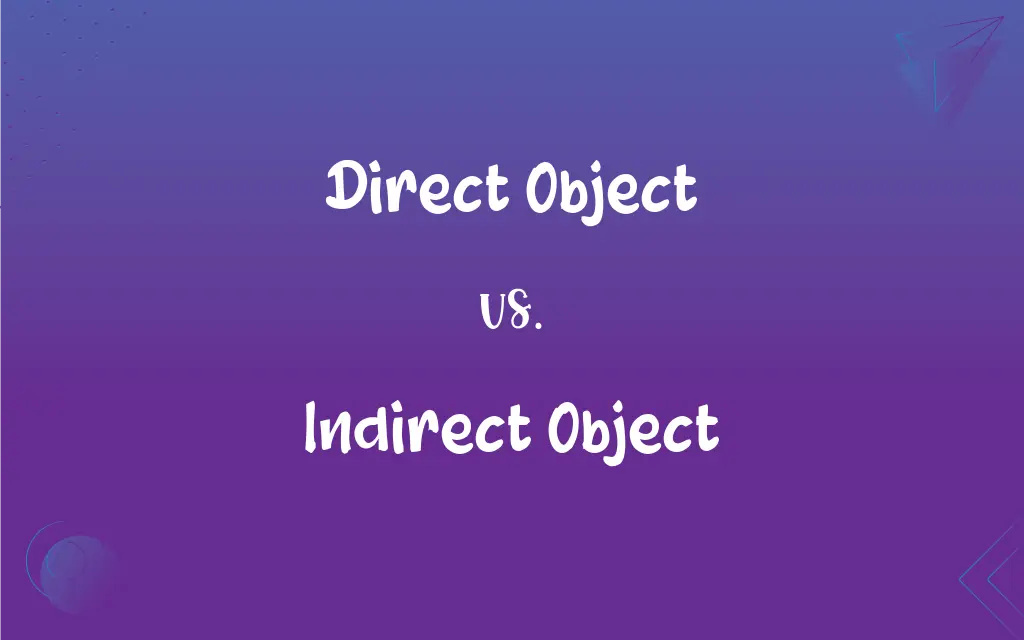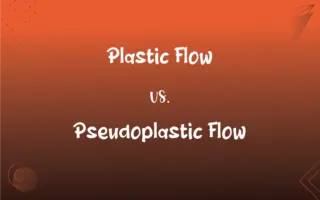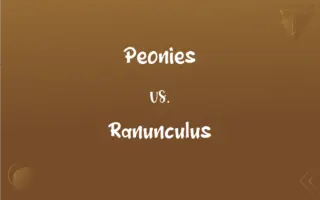Direct Object vs. Indirect Object: What's the Difference?
By Janet White || Published on March 2, 2024
A direct object receives the action of the verb directly, while an indirect object benefits from the action indirectly.

Key Differences
The distinction between direct objects and indirect objects is a fundamental aspect of sentence structure in English grammar. A direct object is the noun or pronoun that directly receives the action of the verb. It answers the question of "what?" or "whom?" with respect to the verb. An indirect object, on the other hand, is the noun or pronoun that indirectly benefits from the action of the verb. It typically answers the question of "to whom?" or "for whom?" the action of the verb is performed.
Direct objects are essential for completing the meaning of transitive verbs, those verbs that require an object to express a complete thought. Without a direct object, sentences with transitive verbs can seem incomplete or unclear. Indirect objects add another layer of nuance, indicating who is affected by or receives the benefit of the action, but they are not always necessary for the sentence to make sense.
The presence of an indirect object often implies that there is a direct object in the sentence, but the reverse is not necessarily true; a sentence can have a direct object without having an indirect object. Indirect objects typically precede the direct object when both are present in a sentence without prepositions, although they can also follow the direct object when introduced by prepositions like "to" or "for."
Understanding the roles of direct and indirect objects is crucial for mastering sentence construction and improving clarity in communication. Recognizing these elements helps in parsing sentences accurately, enhancing both writing and comprehension skills in English.
Comparison Chart
Function in Sentence
Receives the action of the verb directly.
Benefits indirectly from the action of the verb.
ADVERTISEMENT
Answers the Question
What? or Whom?
To whom? For whom?
Dependency
Essential for transitive verbs to complete sense.
Optional; adds nuance but not always necessary.
Position in Sentence
Follows the verb directly.
Precedes the direct object or follows with "to/for".
Example Sentence
"She reads a book."
"She gives her friend a gift."
Direct Object and Indirect Object Definitions
Direct Object
Noun or pronoun receiving the action of the verb.
The dog chased the ball.
ADVERTISEMENT
Indirect Object
Answers "to whom?" or "for whom?" the action is done.
He bought his friend a gift.
Direct Object
Directly affected by the action of the verb.
They won the game.
Indirect Object
Noun or pronoun benefiting indirectly from the verb’s action.
She gave her brother a present.
Direct Object
Essential for the completeness of transitive verbs.
He eats an apple.
Indirect Object
Positioned before the direct object or after with "to/for".
Laura told her teammate the secret.
Direct Object
Can be a person, place, thing, or idea acted upon.
We visited the museum.
Indirect Object
Indicates the recipient or beneficiary of the action.
I made my family dinner.
Direct Object
Answers "what?" or "whom?" after the verb.
She wrote a letter.
Indirect Object
Usually paired with a direct object in a sentence.
They sent their parents postcards.
FAQs
Can a sentence have both a direct and indirect object?
Yes, many sentences contain both, with the indirect object typically appearing before the direct object.
What is a direct object?
A direct object is the noun or pronoun that the verb acts upon directly in a sentence.
How do you identify an indirect object?
Look for who is receiving the direct object by asking "to whom?" or "for whom?" the action is done.
How do you find the direct object in a sentence?
Ask "what?" or "whom?" after the verb.
Are direct objects always necessary in sentences?
Only with transitive verbs; intransitive verbs do not have direct objects.
Can any noun or pronoun be a direct object?
Yes, as long as it receives the action of a transitive verb directly.
What role do prepositions play with indirect objects?
Prepositions like "to" and "for" can introduce indirect objects when they follow the direct object.
What is an indirect object?
An indirect object is the noun or pronoun that indirectly benefits from the action of the verb.
How can the position of an indirect object change in a sentence?
It can precede the direct object without a preposition or follow it with prepositions like "to" or "for."
What happens if you remove the direct object from a sentence?
The sentence may become incomplete or its meaning unclear if the verb is transitive.
How does understanding direct and indirect objects improve writing?
It enhances sentence structure, clarity, and the precision of communication.
Can a sentence have an indirect object without a direct object?
No, an indirect object implies the presence of a direct object to which the action is being done.
What is the difference between a direct object and a complement?
A direct object receives the verb's action, while a complement provides additional information about the subject or object.
How do direct and indirect objects function in passive sentences?
In passive constructions, the direct object often becomes the subject, and the indirect object remains or is introduced by a preposition.
Can pronouns serve as direct and indirect objects?
Yes, pronouns often replace nouns as direct or indirect objects for conciseness and clarity.
Is it possible to omit indirect objects for stylistic reasons?
Yes, especially if the indirect object is clear from the context or to achieve a certain stylistic effect.
Do all sentences have indirect objects?
No, indirect objects are not necessary for all sentences, only where there's a recipient of the action.
Can a sentence have multiple direct objects?
Yes, some verbs can act on more than one direct object simultaneously.
Can direct and indirect objects be implied rather than stated?
Yes, in some contexts, the object(s) may be understood from previous discussion or common knowledge.
How does the presence of direct and indirect objects affect verb choice?
Some verbs inherently require direct objects (transitive), while others do not (intransitive), influencing sentence structure and meaning.
About Author
Written by
Janet WhiteJanet White has been an esteemed writer and blogger for Difference Wiki. Holding a Master's degree in Science and Medical Journalism from the prestigious Boston University, she has consistently demonstrated her expertise and passion for her field. When she's not immersed in her work, Janet relishes her time exercising, delving into a good book, and cherishing moments with friends and family.































































